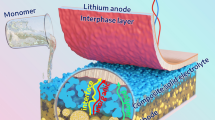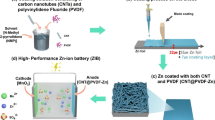Abstract
In the present study, a new type of cathode-active polymeric material was synthesized via a synthetic strategy which involves a series of high-yield and simple chemical reactions performed on a commercially available and relatively cheap polymer, poly(p-chloromethylstyrene). Polymeric support for the electro-active TEMPO was obtained by nitroxide-mediated polymerization (NMP) of p-chloromethyl styrene. This polystyrene derivative was converted to a polymer with pendant electro-active TEMPO radical groups via an azidation reaction which was followed by a click reaction with an alkyne functionalized TEMPO derivative. The obtained polystyrene bearing TEMPO radical polymer possessed a high spin density of 1.4 × 1021 spin/g indicating that electro-active TEMPO groups were successfully attached to the polymer with high yield. The composite cathode material obtained by mixing this TEMPO functionalized polymer with graphite showed a reversible electrochemical redox behavior in a cyclic voltammetry (CV) study vs. Li metal anode. The Li-battery constructed using this cathode maintained 83 % of the its initial capacity (35 mAh/g) over 80 cycles with a cell potential of 3.8 V.

















Similar content being viewed by others
References
Tarascon JM, Armand M (2001) Issues and challenges facing rechargeable lithium batteries. Nature 414:359–367
Winter M, Brodd RJ (2004) What are batteries, fuel cells, and supercapacitors? Chem Rev 104:4245–4269
Whittingham MS (2004) Lithium batteries and cathode materials. Chem Rev 104:4271–4301
Nishide H, Suga T (2005) Organic radical battery. Electrochem Soc Interface 14:32–36
Nishide H, Oyaizu K (2008) Toward flexible batteries. Science 319:737–738
Nakahara K, Iwasa S, Satoh M, Morioka Y, Iriyama J, Suguro M, Hasegawa E (2002) Rechargeable batteries with organic radical cathodes. Chem Phys Lett 359:351
Nesvadba P, Bugnon L, Maire P, Novak P (2010) Synthesis of a novel spirobisnitroxide polymer and its evaluation in an organic radical battery. Chem Mater 22:783–788
Suga T, Sugita S, Ohshiro H, Oyaizu K, Nishide H (2011) p- and n-type bipolar redox-active radical polymer: toward totally organic polymer-based rechargeable devices with variable configuration. Adv Mater 23:751–754
Liang Y, Tao Z, Chen J (2012) Organic electrode materials for rechargeable lithium batteries. Adv Energy Mater 2:742–769
Suga T, Nishide H (2012) Redox-Active Radical Polymers for a Totally Organic Rechargeable Battery. ACS Symposium Book Series, “Polymers for Energy Storage and Delivery: Polyelectrolytes for Batteries and Fuel Cells” 1096: 45–53
Bahceci S, Esat B (2013) A polyacetylene derivative with pendant TEMPO group as cathode material for rechargeable batteries. J Power Sources 242:33–40
Aydin M, Esat B, Kilic C, Kose ME, Ata A, Yılmaz F (2011) A polythiophene derivative bearing TEMPO as a cathode material for rechargeable batteries. Eur Polym J 47:2283–2294
Opsteen JA, Van Hest JCM (2005) Modular synthesis of block copolymers via cycloaddition of terminal azide and alkyne functionalized polymers. Chem Commun 1:57–59
Sinirlioglu D, Muftuoglu AE (2011) Synthesis of an inorganic-organic hybrid material based on polyhedral oligomeric silsesquioxane and polystyrene via nitroxide- mediated polymerization and click reactions. Des Monomers Polym 14:273–286
Ergin M, Kiskan B, Gacal B, Yagci Y (2007) Thermally curable polystyrene via click chemistry. Macromolecules 40:4724–4727
Gacal B, Akat H, Balta DK, Arsu N, Yagci Y (2008) Synthesis and characterization of polymeric thioxanthone photoinitatiors via double click reactions. Macromolecules 41:2401–2405
Ozden S, Celik SU, Bozkurt A (2010) Synthesis and proton conductivity studies of polystyrene-based triazole functional polymer membranes. J Polym Sci A Polym Chem 48:4974–4980
Acknowledgments
This work was financially supported by TUBITAK (The Scientific and Technological Research Council of Turkey) under the project number 112T516.
Author information
Authors and Affiliations
Corresponding author
Rights and permissions
About this article
Cite this article
Sertkol, S.B., Sinirlioglu, D., Esat, B. et al. A novel cathode material based on polystyrene with pendant TEMPO moieties obtained via click reaction and its use in rechargeable batteries. J Polym Res 22, 136 (2015). https://doi.org/10.1007/s10965-015-0777-4
Received:
Accepted:
Published:
DOI: https://doi.org/10.1007/s10965-015-0777-4




